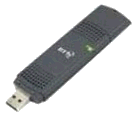More on wi-fi
The world is slowly going wi-fi, and as the technology's a common feature on our shows, we thought we'd add some information on wireless technology, and what wi-fi offers
What is wi-fi?
We first featured wi-fi in Show #05 of our podcast, and revisited the subject in Show 40. wi-fi is a protocol that allows fast exchange of data over a wireless network. For consumers, there are several practical uses:
- Connect your PC to a broadband router without needing to run ethernet cables to your router and phone socket.
- Share your connection without wires - If you have more than one computer, perhaps a laptop or a PDA (or even a Nabaztag) then they can share your Internet connection over wi-fi.
- Home entertainment - You can stream MP3 or Internet radio around the house without wires.
- Other equipment - Such as a printer or a wireless webcam, can be connected to your system wirelessly.
- Voice-over-IP. With a suitable phone, you can make use of a special wi-fi phone to make and receive cheap/free calls over the Internet, wirelessly. There are handsets around, such as the wi-fi phone from SMC Networks for use on Skype, or the BT Hub Phone.
- Home networking - Share out folders and files on your PC, to be picked up by other devices
|
We featured wi-fi, and ways to get a better wireless connection in Show 40. |
What else should I know about wi-fi?
- There are three different standards: 802.11b - the first version, with speeds to up to 11 megabits a second, then 802.11g - much faster at 54Mbps. Now, we have 802.11n - even faster with a better range
- Range - Varies, but typically good enough to connect the average house
- Security - Make sure you enable WPA security, to help stop people in range of your setup hijacking your connection
- wi-fi Max could be coming soon. This involves wide-area wi-fi, perhaps for a small town or community
How do I get wi-fi?
Essentially, it's a case of looking for wi-fi enabled equipment. Here's a quick example of what you may need to wi-fi your home:
wi-fi example: A household has a desktop PC and a laptop. The house already has a broadband connection, but the family wants to be able to share the Internet connection wirelessly. There are several different ways of setting up a house for wi-fi access, but for this example, we'll pick a common method, to give you some general ideas and information:
|
Your questions?
Q. Is wi-fi safe?Well, wi-fi signals are transmitted in the 2.4GHz range. In Europe, the maximum permitted radiated output power of a wi-fi device is 0.1 Watt (20 dBm). A wi-fi device had a maximum range of just 90 metres. Compare this with a GSM mobile phone which can have a peak power output of up to 2 watts when transmitting to a base station often some miles away. Mobile phones can output around twenty times the power of a wi-fi router, and you hold those close to your head. Seems that radiation from wi-fi is much lower than the dose you get from being close to a mobile phone or a base station.
If you're interested in reading more, try Is wi-fi bad for humans? which gives an example of one year being in a room with wi-fi is equal to 20 minutes on a mobile phone
Q. I'm not getting a signal from my wi-fi router. How can I increase the range?A. It's generally acknowledged that WPA is a better form of wireless security than WEP. WPA stands for Wireless Protected Access, and there are a couple of variants. In the home environment, you may find WPA-PSK, which uses a different kind of security as the home environment doesn't have a corporate server to exchange security keys with. WPA2 is the current version, and is compliant with a new security standard (802.11i) and began rolling out in 2006.
wi-fi signals have a limited range, and walls, doors, radiators, etc can all reduce the range of the signal. You can try repositioning your router away from obstructions especially metal. Moving your router closer to the centre of a house increases the chance of home-wide coverage. You can also try repositioning your router's aerial(s), and changing the height-from-ground. Just repositioning a few feet can sometimes make all the difference.
If you still get no joy, consider a wi-fi extender. At the time of writing, there are two at Maplin, the Network Range extender - these can be used to boost your wireless network coverage. These can be placed around your home or office to fill in dead spots or to extend range. You can also try Dabs.com for wireless network extenders.
If, for some reason, you don't want to use wi-fi to connect equipment to your Broadband router, you could run Ethernet cabling from your Broadband router to equipment elsewhere in your home, but cabling isn't always a particularly neat option. There is another option - The HomePlug (also known as a Powerline Adapter). These allow you to feed computer data around your home using your existing mains wiring. Plug in a HomePlug to a power socket near your router, and plug an RJ45 data lead into the HomePlug. From elsewhere in the house, plug in another unit, for access to the 'Net over the mains wiring. For more on these, see our Powerline Adapter page.
You can get HomePlugs, such as the MicroLink dLAN Starter Kit (pictured here) from Maplin and Dabs.com.
Got a question on wi-fi that we can answer in the next show? Call 020 8133 4567 or send us a message
 Assuming the house already has
Assuming the house already has 